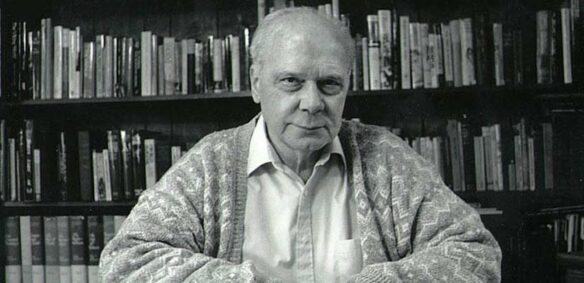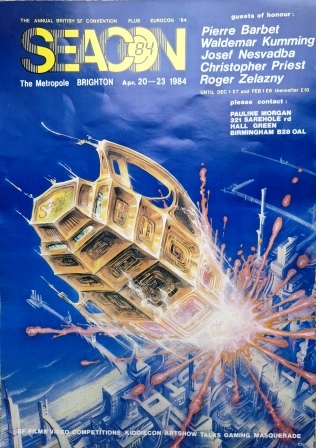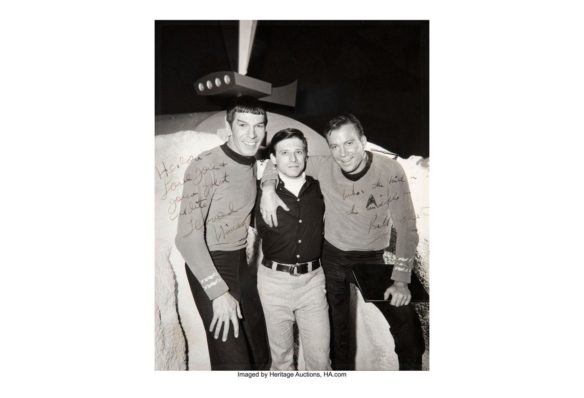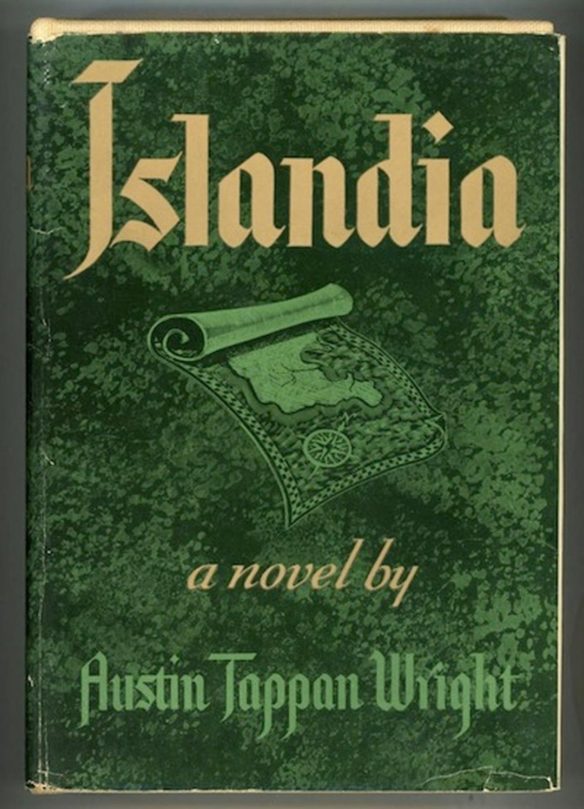(1) WHAT’S ‘BEST’ THIS YEAR. Siobhan Maria Carroll reviews the 2024 editon of Best American Science Fiction and Fantasy in “Science Fiction, Fantasy, and the End of Earnestness” at Los Angeles Review of Books.
NOW IN ITS 10TH year, the annual Best American Science Fiction and Fantasyanthology provides an excellent overview of short genre fiction published in the United States. Each year, series editor John Joseph Adams selects 80 short stories from SF magazines and literary journals for blind review by a guest editor, who chooses their favorites from among them. This process maintains a high level of quality and consistency, while also allowing the guest editor to make a distinctive mark on each collection.
Hugh Howey, the 2024 guest editor, rose to fame after his self-published dystopian story“Wool” (2011) became an online sensation, leading to his stories’ distribution by Simon & Schuster and their adaptation into the Apple TV+ series Silo (2023– ). As might be expected for an author with a good eye for the market, Howey’s choices for the 2024 collection steer more toward the crowd-pleasing than those of my favorite series entry—the 2019 volume edited by Carmen Maria Machado. The result, however, is an impressive array of stories that will likely appeal both to casual readers and would-be writers….
… The high-water mark of the new millennium’s Age of Earnestness (the supposed successor to the 1990s Age of Irony) was directly tied to the rise of Twitter, as well as to a reading culture where attempts at nuanced expression could swiftly fall victim to dogpiles and hot takes. At least 12 of the 20 stories included in this volume (several of them from writers outspoken on social justice issues) were published in online magazines in 2023 in the wake of Twitter’s post-Musk exodus. Writing this review in the aftermath of the American election, I cannot help but perceive these stories as anticipatory responses to a changed technological and social culture. They are less overt in their depiction of “good” politics than previous entries in the Best American series, more interested in the psychology of “bad” and morally ambiguous characters, and more interested in depicting characters whose ability to change oppressive systems is limited or nonexistent….

(2) JOHN BARROWMAN NOW CLAIMS VICTIMHOOD STATUS. “’It was crap’: John Barrowman still refuses to take accountability for his actions” according to The Mary Sue.

Another day, another man fails to see how his sexually inappropriate behavior is wrong. This time around the man is John Barrowman, who up until a few years ago was one of Doctor Who’s most beloved stars. He played Captain Jack Harkness, one of the first pansexual characters on British TV, and was one-half of the show’s very first same-sex kiss. Fans adored him for his charm and charisma. That’s no longer the case.
Barrowman’s downfall was the result of another sexual misconduct allegation. In 2021, Noel Clarke, who played Mickey Smith on the show, was accused of sexual harassment by multiple women. Any chance of his ever returning to Doctor Who went up in smoke, as did his career. During this media storm, journalists uncovered some old footage of Clarke at a 2015 convention discussing Barrowman’s dubious behavior. He spoke about how Barrowman was allegedly constantly “taking his d*** out” on set and once even rested it on co-star Camille Coduri’s shoulder when they were in a makeup truck (she confirmed that she remembered this incident in the video but offered no further context). Seemingly, this had been tolerated for a while—but it wasn’t about to be tolerated any longer.
It turned out that Barrowman had been called out for his behavior in the past, but had seemingly learned nothing. In 2008, he admitted to exposing himself during a BBC Radio 1 show and apologized for it, saying he “went too far.” This apology was seemingly at the forefront of his mind when he made another apology in the wake of the 2021 allegations.
“With the benefit of hindsight, I understand that upset may have been caused by my exuberant behavior and I have apologized for this previously,” he said in a statement. “Since my apology in November 2008, my understanding and behavior have also changed.”
But apparently, this actually resulted in Barrowman learning nothing. Instead of changing and growing, he’s simply bitter that he lost his Doctor Who gig and a large portion of his entertainment career. He said as much to Wales Online recently. “I think I’ve been badly treated, definitely,” he complained. “I’m disgusted at the way my Doctor Who and Torchwood family turned their backs on me—99% of the things that were said about me were bulls***.”
Barrowman claimed that “no one was offended, no one was upset,” by his actions—but clearly, this isn’t true if he was delivering apologies. “It was crap,” he went on. “I ended up being good clickbait and it has lasted for three years. It’s been devastating—to the point I was blackballed. I can’t get into a room for an audition or a meeting anymore.”…
(3) DROPPING GENRE NAMES. Shelf Awareness brings us “Reading with… Carter Wilson”:
Book you’re an evangelist for:
William Goldman’s The Princess Bride. This might have been the only book I had to read in high school English that I fell in love with. The sheer creativity of Goldman is astonishing.
Book you’ve bought for the cover:
Well, it’s much more common I don’t buy a book because of the cover. But I will say I was persuaded by the gorgeousness of Anne Rice’s complete Vampire Chronicles. Gorgeous wrought-iron detailing all over the cover of that one
Book that changed your life:
The Road by Cormac McCarthy. Not sure any book has truly changed my life, but The Road is a book that forces you to read every single word. I can’t think of any other author whose use of language is as compelling as McCarthy’s.
Favorite line from a book:
“Don’t Panic.” –Douglas Adams, The Hitchhiker’s Guide to the Galaxy…
(4) WHERE CASTLE? If any Filefolk happen to be in the Paris area this summer: “Rare manuscript from middle ages that inspired Disney castle to go on display for first time in 40 years” in the Guardian. Despite the headline, the article never says what Disney castle they’re talking about. I guess you’re just supposed to know. However, the castle at the original Disneyland took its cues from Bavaria’s Neuschwanstein Castle.
… Pages from Les Très Riches Heures (The Very Rich Hours) – an elaborately decorated prayer book from the 15th century – will be exhibited at the Château de Chantilly, north of Paris, after a costly restoration. It has not been seen, even by historians and academics, since the 1980s….
…He said the exhibition would also feature books from the duke of Berry’s collection on display for the first time since the 15th century. Berry, known as John the Magnificent, whose motto was “Le Temps venra” (the time will come), was one of medieval France’s greatest patrons of the arts and collected illuminated manuscripts.
Deldicque said the restoration of Les Très Riches Heures would be completed after the exhibition closes and the manuscript returns to the museum’s archive.
“It is too fragile and at risk of damage from light to be on permanent display,” he said. “That’s why this exhibition will be unique. Everyone knows about this book – but nobody has seen it.”…
(5) ON THE HORROR TRAIL. [Item by Steven French.] For the travelling horror fan, Atlas Obscura has compiled a list of fourteen must-see places to visit: “14 Haunting Places in Literature”.
There’s nothing quite like a horror story. The supernatural and macabre have haunted our imaginations for centuries—and inspired writers for centuries to create works that can terrify us.
We’ve compiled a list of our favorite places across the world that have appeared in horror literature, from Bram Stoker’s Dracula to places that inspired Edgar Allan Poe before his death. Take a spine-tingling tour of these horror-inspiring locations—if you dare….
Here’s one of their bizarre destinations.
“The Raven that Inspired Dickens and Poe”
Perched on a log in the Rare Books department of the Free Library of Philadelphia stands a strange piece of history. Dead since 1841, but preserved with arsenic, and frozen inside a shadow box, this bird’s legacy is longer than most people’s. The raven’s name is Grip. Grip the Clever, Grip the Wicked, Grip the Knowing.
Once Charles Dickens’ pet raven, upon its death Dickens had it professionally taxidermied and mounted. Grip even makes an appearance in Barnaby Rudge, one of Dickens’ lesser-known stories.
The book was reviewed for Graham’s Magazine by its literary critic at the time, Edgar Allan Poe. Poe wrote that “[the raven’s] croaking might have been prophetically heard in the course of the drama.” It wasn’t long after this that Poe published his breakout work “The Raven.” The coincidence didn’t escape notice, and Poe was taunted with the refrain “Here comes Poe with his Raven, like Barnaby Rudge, / Three fifths of him genius, two fifths sheer fudge.”
Despite this, “The Raven” was a smashing success and Poe enjoyed performing readings at fancy salon parties. He would turn down all the lights and recite the poem with great drama. Everyone referred to him as “the Raven,” but it would only be four years after publishing “The Raven” and gaining worldwide fame that Poe would be found delirious on the streets of Baltimore, dying shortly thereafter….
(6) CHRISTOPHER BENJAMIN (1934-2025). Actor Christopher Benjamin died January 10 at the age of 90. The portion of his career of interest to sff fans is noted by the Guardian’s obituary:
With a portly but athletic physicality, a rich baritone voice, a bloodhound, drooping visage and a sarcastic sense of humour, Christopher Benjamin, who has died aged 90, was a backbone actor on television, but mostly stage, for many years.
He had a sort of internet afterlife when his role as Henry Gordon Jago in the BBC TV 1977 Doctor Who saga The Talons of Weng-Chiang was reprised in an audio supernatural mystery series from 2010 to 2021.
Benjamin was on TV and radio from 1965, appearing in Z Cars, The Avengers, The Saint, Jason King and, notably as the same character, Potter, in Danger Man and its more surreal, sci-fi spin-off, The Prisoner, both starring Patrick McGoohan. …
(7) MEMORY LANE.
[Written by Cat Eldridge.]
January 26, 1994 — Babylon 5 series premieres
Thirty-one years ago on PTEN, the Prime Time Entertainment Network, a syndicated network organized by Warner Brothers, the Babylon 5 series premiered. It was created by writer and producer J. Michael Straczynski. It followed Babylon 5: The Gathering (1993), the pilot film which aired a year earlier. It would run for five twenty-two episode seasons as planned plus six related films.
It generated a spin-off series, Crusade, but that only lasted thirteen episodes. Two other series were planned, The Legend of the Rangers and The Lost Tales, but neither got past the pilot.
Its cast was marked by tragedy with a number of the principal actors dying young including Mira Furlan, Richard Biggs, Jeff Conaway, Jerry Doyle, Andreas Katsulas and Michael O’Hare.
It won two Hugo Awards for “The Coming of Shadows” at L.A. Con III and “Severed Dreams” at LoneStarCon II.
Babylon 5 in the revised print is streaming currently on Prime. I’m going to rewatch it this Winter as I’ve not seen it in at least a decade.

(8) TODAY’S BIRTHDAY.
[Written by Paul Weimer.]
January 26, 1918 — Philip José Farmer. (Died 2009.)
By Paul Weimer: Philip José Farmer first came to my attention as a name mentioned in the famous “Appendix N” of the original Advanced Dungeon Master’s Guide. Like the rest of the entries in that bibliography, it just listed his name, and a book title (“World of Tiers, et al”) and that was it.
Not long thereafter, though, I came across issue 37 of Dragon Magazine, which was an in-house organ for TSR that mostly focused on D&D and (early on) other TSR games as well. Anyway, in issue 37, Ed Greenwood wrote an article called “From the City of Brass to Dead Orc Pass in one small step. The theory and use of Gates.” As someone who was already clued into my love of multiverse stuff, this was a formative article for me.
In that article, Greenwood mentions The World of Tiers as “The magnum opus of gate systems”. He mentioned a number of other authors (particularly Moorcock and Cherryh) but I had remembered the mention of Farmer in the AD&D book and now really wanted to find The World of Tiers books, and now had the titles of each and every one.
And so I read them and was immediately absorbed into the story of Robert Wolff, who is not the suburban homeowner he really thinks he is, but someone far older, more powerful and more dangerous. I also saw that Kickaha, the trickster who sets off Wolff on his adventure, was in fact, an even more interesting character with a complicated story (and very possibly an author insert character).
From Tiers, I soon discovered the Riverworld novels, and got hooked on the idea of historical characters being pitted against each other after waking up on the titular planet, and much else besides. It’s one of the most interesting settings ever created in SFF. I remember back in the day, daydreaming what I would do if I woke up on the Riverworld. (The copy I had stressed and made it clear that everyone who ever lived “including you” was going to wake up on the planet.) I also weirdly associate the Billy Joel song “River of Dreams” with Riverworld as well.
I recall a shared world of novels that he created the setting for, the “Dungeon”. Farmer didn’t write any of the novels himself, but instead created the setting for a series of writers to play in. Like Tiers, it was a world involving Gates and strange planes, but as you might guess from the title, this was really a “prison plane” that the main character, Clive, is trying to penetrate to find his missing brother. What I particularly remember is that the novels with different authors took very big “Swings” back and forth, with authors in subsequent books retconning major events in previous books. I got the sense that the authors did not like the ideas of their counterparts all that much. It does make the series not satisfactory overall, and I can’t imagine ever trying to reread it, but it was memorable for its imagery and imagination.
Farmer is the second author, after Heinlein, that I read who tried to synthesize a lot of his characters and settings into as much of a single coherent whole as possible, particularly with his Wold Newton works.
My favorite Farmer besides all of the goodness of Tiers and Riverworld might be The Gate of Time, eventually renamed Two Hawks from Earth. It featured a Native American pilot flying over Romanian airfields during WWII who gets blasted into an alternate history where the migrations of the Native Americans into North America didn’t happen, and they instead rolled westward into Europe, drastically changing the development of Europe instead. I loved how our protagonist tries and figure out what he is dealing with, a culture very different than anything he remembers, and gets caught up in intrigue and adventure. And really, that is what Farmer’s works have always done for me — entertaining action adventures that keep the pages turning.

(9) COMICS SECTION.
- Arctic Circle tells what sound effects really mean.
- Carpe Diem shows the moment before caffeine.
- Foxtrot gets carried away with a theme.
- Free Range provides arrivals with greeters.
- Ink Pen opts for the easy disguise.
- Off the Mark sleeps in comfort.
- Thatababy plays a shell game. How many do you know?
(10) WET WORK. “Monster Devastated To See Film Depicting Things He Told Guillermo Del Toro In Confidence” – read all about it in The Onion.
Saying he felt humiliated by such a public betrayal of his trust, a monstrous abomination known as the Bog Freak told reporters Friday that he was devastated to have seen a movie depicting things he told filmmaker Guillermo del Toro in confidence….
(11) RESEARCHERS STICK WITH IT. Futurism reports “Scientist Testing Spider-Man-Style Web Shooters He Accidentally Made in Lab”.
Tufts University biotech researcher Marco Lo Presti made an astonishing discovery while investigating how silk and dopamine allow mussels to stick to rocky surfaces.
“While using acetone to clean the glassware of this silk and dopamine substance,” he told Wired, “I noticed it was undergoing a transition into a solid format, into a web-looking material, into something that looked like a fiber.”
Lo Presti and his colleagues immediately got to work, investigating whether the sticky fibers could be turned into a “remote adhesive.”
The result is an astonishingly “Spider Man”-like silk that can be shot not unlike the superhero’s wrist-mounted web shooters, as detailed in a paper published in the journal Advanced Functional Materials last year.
While it won’t allow an adult person to swing from skyscraper to skyscraper any time soon, the results speak for themselves. Footage of the team’s experiments shows strands of the material being dripped onto a number of objects from several inches above, forming a solid connection in a matter of seconds and allowing the object to be carried away.
The researcher’s collaborator, Tufts engineering professor Fiorenzo Omenetto, recalled being caught off guard by the accidental discovery….
(12) LONG NUMBERS TAKE DEEP POCKETS. In “New Prime Number, 41 Million Digits Long, Breaks Math Records”, Scientific American tells how the search operates. Oh, and that this particular search cost maybe $2 million to do.
…Last fall a new entry came from Luke Durant, a researcher in San Jose, Calif. Durant’s discovery unseated the former record holder for the largest prime, which had gone uncontested for nearly six years, an unprecedentedly long reign in the modern search for such numbers. The gap makes sense: the bigger primes are, the further apart they end up, making each new find harder than the last.
The new prime contains a mind-boggling 41,024,320 digits. To put that in perspective, the estimated number of atoms in the observable universe has around 80 digits. Each additional digit increases a number by 10 times, so the size of the new prime lives far beyond human intelligibility. Primes play a major role in pure math, where they’re main characters in a field called number theory, and in practice, where, for example, they underlie widely used encryption algorithms. A prime with 41 million digits won’t immediately join the ranks of useful numbers, but for now it adds a feather in the cap of a community that longs to apprehend the colossal….
… When asked how much money his project cost in an interview with Numberphile on YouTube, Durant said, “I believe it’s under $2 million.” That’s a hefty investment compared with the prime-search project’s prize of $3,000, which he plans to donate to the high school he attended, the Alabama School of Mathematics and Science….
[Thanks to Cat Eldridge, SF Concatenation’s Jonathan Cowie, Steven French, Kathy Sullivan, Teddy Harvia, Mike Kennedy, Andrew Porter, John King Tarpinian, and Chris Barkley for some of these stories. Title credit belongs to File 770 contributing editor of the day Cat Eldridge.]







